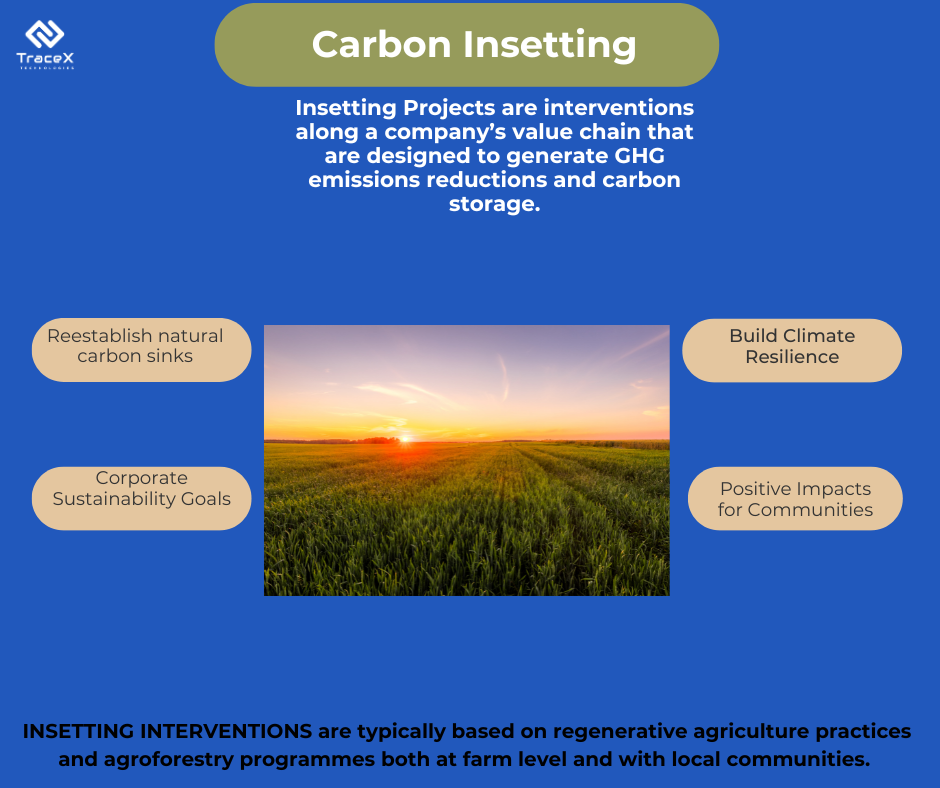Contact: +91 99725 24322 |
Menu
Menu
Quick summary: Explore the transformative concept of Carbon Insetting and its role in sustainable agriculture. Uncover how businesses can reduce carbon emissions, partner with stakeholders, and implement climate-smart practices at the farm level. Dive into the nuances of insetting credits, co-benefits, and the positive impact on climate resilience and supply chain stability. Discover the path to sustainable agriculture through our insightful exploration of Carbon Insetting.

Agricultural practices are evolving, but can carbon insetting be the sustainable solution we’ve been waiting for? If you’re invested in sustainable agriculture, the search for impactful practices is crucial. Avoiding missteps is key to making a positive impact.
According to IPI, tackling the climate emergency and reversing the loss of nature requires urgent action by all the sectors of society with an integrated approach that is in line with science and has nature-based solutions at its core.
Did you know that carbon insetting in agriculture has the potential to sequester substantial amounts of carbon dioxide? Studies show that implementing regenerative practices, such as cover cropping and agroforestry, can capture and store carbon in the soil, mitigating climate change while promoting sustainable farming. This transformative approach benefits the environment and enhances soil health and agricultural resilience.
Dive into this blog to uncover the potential of carbon insetting and how it’s reshaping the future of sustainable agriculture.
Carbon insetting is a sustainable agriculture strategy where businesses invest in carbon sequestration projects within their supply chains. In the realm of agriculture, it involves recognizing and mitigating the carbon emissions linked to farming practices, food production, and associated activities within your business and throughout the value chain.
By implementing practices like reforestation and soil carbon enhancement, companies offset their carbon emissions. This approach helps meet sustainability goals and fosters environmental stewardship within the agricultural sector. Carbon insetting promotes a holistic, regenerative approach, aligning economic interests with ecological restoration for a more sustainable and resilient food production system.
Insetting encourages a comprehensive perspective on the entire lifecycle of a company’s operations, considering both upstream activities such as raw material purchase and transport, and downstream activities like product use and end-of-life. By embracing insetting, companies can collaborate with essential stakeholders in their value chains to minimize greenhouse gas emissions and play a role in achieving climate change mitigation goals.

Insetting initiatives typically focus on adopting climate-smart practices at the farm level and within local communities. Examples include reducing the use of synthetic inputs, implementing drip irrigation systems and renewable energy technologies, minimizing tillage practices, and maximizing cover and intercropping. These activities can generate insetting credits, and they also bring co-benefits by conserving and restoring landscapes, enhancing climate resilience, and ensuring stability in a company’s supply chain.
On-Farm Practices: Carbon insetting employs diverse agricultural practices to enhance carbon sequestration. Techniques include afforestation, agroforestry, cover cropping, and reduced tillage. These methods promote soil health, increase organic matter, and capture carbon dioxide, mitigating climate change impacts. By integrating these practices, carbon insetting not only reduces greenhouse gas emissions but also fosters sustainable and regenerative agriculture.
Carbon Sequestration: Carbon is stored in soils through the decomposition of organic matter, with microbes breaking down plant material and converting it into stable soil carbon. In vegetation, carbon is sequestered through photosynthesis, where plants absorb carbon dioxide and convert it into organic compounds. Forests, wetlands, and sustainable agricultural practices play crucial roles in storing carbon, contributing to climate change mitigation.
Measurement and monitoring of carbon insetting involve advanced technologies such as remote sensing, satellite imaging, and ground-based sensors. These tools assess changes in land cover, vegetation health, and soil carbon content. Additionally, sophisticated modeling techniques and data analytics help quantify the effectiveness of carbon sequestration efforts, ensuring accurate tracking and reporting of environmental impact.
Digital tools and platforms play a crucial role in tracking and reporting carbon insetting data. Utilizing advanced software, companies can monitor and analyze changes in land use, vegetation, and soil carbon levels. This real-time data enables accurate reporting, transparency, and the efficient management of carbon offset projects, enhancing the effectiveness of sustainable practices and contributing to a more informed and accountable approach to environmental stewardship.
Farmers and agricultural stakeholders encounter several challenges in adopting carbon insetting practices.
Overcoming these challenges requires targeted support, education, financial incentives, and policy frameworks that promote the integration of carbon insetting into mainstream agricultural practices.
Technology interventions play a crucial role in addressing challenges in carbon inset projects by providing innovative solutions to enhance efficiency, accuracy, and scalability. Here’s how technology can address key challenges:
Data Collection: Digital platforms enable systematic data collection from farmers, capturing essential information such as demographics, land size, crop types, farming practices, and socio-economic status. This process can include both self-reporting by farmers and data obtained through satellite imagery or field visits.
Geospatial Mapping: Geographic Information System (GIS) technology integrated into digital platforms allows for precise geospatial mapping of farmers’ lands. This not only provides a visual representation of farming areas but also facilitates targeted interventions and resource allocation.
Remote Sensing: Satellite imagery and remote sensing technologies can be integrated into digital platforms to gather real-time data on crop health, soil conditions, and other relevant parameters. This enhances the accuracy of farmer profiles and allows for dynamic monitoring.
IoT Sensors in Agriculture: Internet of Things (IoT) sensors monitor soil health, water usage, and other environmental factors. Integrating IoT data into agricultural practices helps in optimizing resource efficiency and reducing emissions.
Blockchain for Traceability: Blockchain technology ensures transparent and immutable tracking of carbon offset activities. It enhances traceability in supply chains, providing a reliable record of emission reductions and sustainable practices.
Data Analytics: Advanced analytics tools process large datasets to identify trends, patterns, and areas for improvement. This helps in making informed decisions and monitoring the impact of carbon offset interventions.
TraceX DMRV (Digital MRV) solutions play a pivotal role in helping companies accelerate their net-zero targets through credible and impactful monitoring, reporting, and verification of carbon sequestration interventions. Here’s how TraceX DMRV facilitates this process:
Many companies have incorporated insetting into their operations in the form of nature-based solutions such as improved agriculture practices, agroforestry, restoration and conversion projects.
Future developments in carbon insetting may see increased integration of technology, with precision agriculture and blockchain enhancing monitoring and transparency. Collaborative initiatives between governments, corporations, and farmers may grow, incentivizing large-scale adoption. Innovations in financing models, like pay-for-performance mechanisms, could make carbon insetting more financially accessible for farmers. The development of standardized protocols for measurement and verification may gain prominence, ensuring consistency in assessing carbon sequestration. Overall, a heightened awareness of the urgency to address climate change is likely to drive policy support and market demand for sustainable agricultural practices, further propelling the growth of carbon insetting initiatives.
In conclusion, carbon insetting stands as a transformative approach to sustainable agriculture, offering a dual solution to climate change and food production challenges. Through innovative practices, technological integration, and collaborative efforts, it has the potential to revolutionize the way we approach farming. As awareness grows and policy frameworks evolve, the economic and environmental benefits of carbon insetting are poised to shape the future of agriculture. By prioritizing the health of our planet alongside agricultural productivity, carbon insetting represents a critical step toward creating a resilient, regenerative, and sustainable food production system for generations to come.
